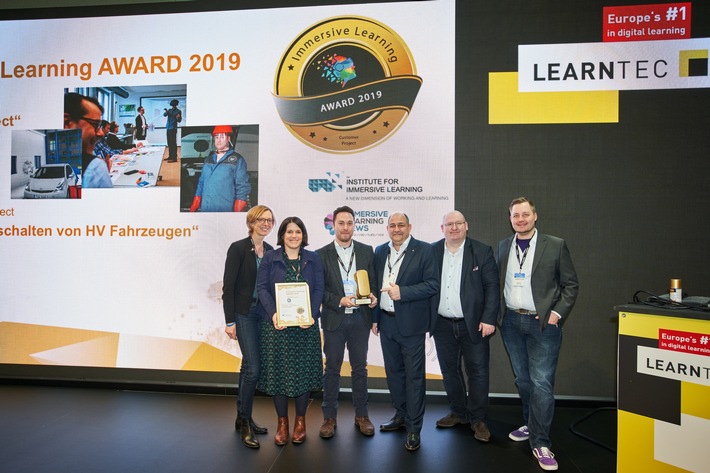Comparing Immersive Training Solutions in 2024
Immersive training solutions are becoming increasingly commonplace in the business environment as companies rapidly adopt XR technologies, the metaverse, and the future of work.
Companies are searching for more agile, scalable solutions that help them overcome skill gaps, improve employee productivity, and enhance engagement in a changing workplace. As a result, immersive learning tools, platforms, and software are being adopted in every industry.
Over the years, studies have shown that immersive training experiences can improve knowledge retention, attract talent to teams, and even reduce upskilling costs. The challenge for business leaders is figuring out which technologies they should invest in.
Here’s your step-by-step guide to comparing immersive training solutions in 2024.
Step 1: Examine Your Current Training Technology
The first step in optimizing your training initiatives with new immersive technology is auditing your existing processes and solutions. Your employees will likely already have access to various resources they use for upskilling and development.
This could include immersive collaboration tools like Microsoft Teams and Teams Immersive Spaces. It can also include learning management systems where you store and author content, and workforce management software to help distribute training resources.
Examining your current software and hardware landscape will help you to identify integration opportunities. For example, if your teams already share knowledge in Microsoft Teams, you may need an XR training solution that integrates with Microsoft Mesh. An audit of your existing environment will also help you to identify what kind of immersive experiences you’re going to create.
For instance, will you ensure every employee can access an XR headset, or will certain team members interact with content through AR apps, laptops, and other devices?
Step 2: Explore the Types of Immersive Training Solutions
Once you have a clear insight into your existing technology stack for training initiatives, the next step is to define what kind of “XR” technology you need. If you want to boost immersion in training experiences among all employees without teaching them how to use MR and VR headsets, you might invest in metaverse environments that employees can access from any device.
If you want to improve employee safety and focus during training sessions, you might explore the realm of virtual reality. For a more collaborative learning experience, you might use AR remote guidance software and applications. These tools can empower subject matter experts to support employees on the job.
Alternatively, you might combine elements of the real and virtual worlds with spatial learning experiences with mixed-reality headsets like the Apple Vision Pro.
Step 3: Consider Your Approach to Immersive Education
When comparing immersive training solutions, it’s important to remember there are various ways to approach professional education. One of the biggest benefits of immersive educational solutions is that they allow companies to create various educational experiences to suit different training needs.
Some platforms empower companies to use gamification strategies, creating fun challenges in the metaverse, where employees can earn rewards and points. Other solutions leverage AI to allow for adaptive learning, enabling course material to adapt according to use input.
Other methodologies to consider include:
- Scenario-based learning: This involves using immersive training technology to replicate real-life scenarios and experiences. It might involve creating digital twins of products, machinery, and environments in a virtual world.
- Story-based learning: Story-based learning is a great way to inject new ideas into a learning situation and encourage users to re-evaluate their assumptions. Immersive training technologies can allow companies to build entire narratives in the metaverse and even create “characters” for immersive environments.
- Instructor-led learning: With instructor-led education, professionals collaborate with staff members and students in real-time as they move through the training journey. They can provide feedback, answer questions, and offer tips as the learner explores.
Step 4: Look for Flexible Immersive Training Software
Some innovators in the immersive training solutions landscape work with experts to develop content libraries. These allow companies to access pre-built educational programs for ddifferent employees. There are apps available for health, manufacturing, and customer service spaces.
However, as your immersive training strategy evolves, it may be helpful to look for platforms that allow you to build and customize your own solutions. A comprehensive and flexible immersive learning platform will allow businesses to adapt their training initiatives to the specific needs of their employees. Leading experts in this industry can help build unique training environments from scratch. They can even design digital twins for the metaverse.
Some companies even offer no-code and low-code platforms. These tools allow companies to embed their data and training guidelines into a pre-built system. Flexible software also ensures companies can scale their training initiatives over time. You can add new classes and courses based on the feedback they get from employees.
Step 5: Prioritize User Experience
Compared to traditional educational initiatives, immersive training solutions often benefit from higher levels of adoption and user engagement. However, your team may still have employees who are resistant to new tools and technologies. To unlock the benefits of an immersive training experience, it’s important to deliver an excellent user experience.
Offer a range of training initiatives to adhere to different learning styles and preferences. Make it easy for staff members to learn how to use XR tools and metaverse environments with onboarding strategies. Additionally, ensure your new technologies integrate with the solutions your employees already use, such as knowledge-sharing platforms and collaboration tools.
If you’re unsure which solutions will give your employees the best user experience, test different resources. Ask early adopters to experiment with XR training software and headsets and gather feedback from their experiences. After implementing these new tools, carefully monitor engagement, participation, and adoption rates.
Choose the Right Immersive Training Solutions
Immersive training tools, solutions, and technologies have the power to enhance and upgrade virtually any employee development initiative. As skill shortages continue to grow, increasingly accessible XR solutions will empower teams to upskill, reskill, and augment their teams.
The key to success is ensuring you implement the right hardware, software, and solutions to give your users an unforgettable training experience.
Quelle:




